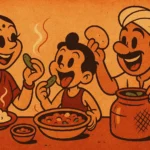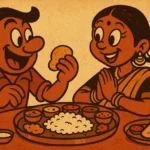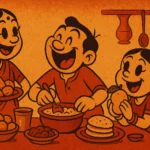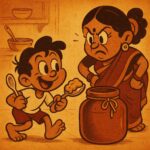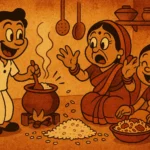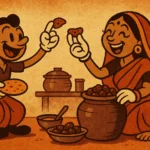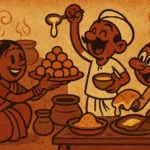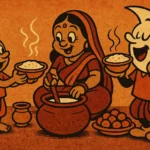When I was a kid visiting Chennai during summer holidays, I thought the banana leaf was just a fancy plate. Disposable, eco-friendly, and slightly confusing if you didn’t angle it right. But it turns out, the banana leaf isn’t just a plate—it’s a blueprint. A thoughtfully laid-out grid of flavors, textures, temperatures, and traditions. Like an edible floor plan. With zoning laws. And a very strict building inspector in the form of my aunt, who once moved my pickle two inches left with such authority I thought I’d violated temple protocol.
The banana leaf meal—or saapadu, if you’re Tamil, or sadya, if you’re from Kerala—isn’t a random dumping of food. It’s order masquerading as abundance. Each dish has a place. Each placement has meaning. And like all great architecture, it’s designed to elevate experience through form and function.
Orientation Matters
First things first: the stem side of the banana leaf always faces to the left. Always. This isn’t just tradition—it’s ergonomics. Most people eat with their right hand, and this orientation makes it easier to scoop from right to left without the leaf folding in on itself. My uncle called it “leaf geometry.” He may have been joking, but it checks out.
The Left Wing: Sharp, Spicy, Sour
This is where the supporting cast lives. From top left to center, you’ll usually find a procession of pickles, thogayal (chutney), kootu (vegetables stewed in lentils), poriyal (stir-fried veggies), and one wildcard—maybe a crispy vazhakkai fry or a tangy puli inji (ginger-tamarind relish).
The arrangement isn’t just aesthetic. It’s a flavor sequence: start sharp, move mellow. Pickle stirs your appetite. Chutney cools it down. The dry sabzi offers crunch, and kootu brings comfort. It’s like a film trailer—just enough drama before the main feature begins.
Center Stage: Rice and Rotations
The center of the leaf is reserved for rice, and not just one kind. South Indian meals come in phases. First, rice with sambar. Then, rice with rasam. Then curd rice. Each phase is served fresh, one after the other, like acts in a play. And you’re expected to eat each act before the next is served—no intermissions, no crossovers.
The rice mound might seem simple, but it’s the stage on which everything else performs. You sculpt it. Shape it. Create channels for the sambar. Fold in the rasam. It’s your canvas, and your fingers are the brushes. By the end, your hands smell of tamarind, cumin, and ghee—and that, truly, is the sign of a successful meal.
The Right Corner: Fried Temptations
On the bottom right lives the crowd-pleaser: appalam (papad), vadam (rice crisps), maybe even a tiny vada if you’re lucky. These are technically “sides,” but in spirit they’re snacks. Crispy, loud, unapologetically salty. Perfect for eating between rice courses, or secretly before the meal even begins.
My cousin and I once got scolded for polishing off the papad before the rice had even hit the leaf. “They are not appetizers,” my grandmother said. “They are companions.” I still don’t fully understand that, but I nod as if I do and pace myself now.
Top Center: The Sweet Spot
Right at the top, above the rice zone, sits the dessert. Payasam, kesari, banana, or all three if the gods are smiling. And yes, it’s served at the beginning—not the end. This stuns most first-timers. But in many homes, the logic is clear: sweet is auspicious. You start with it, so the meal begins with joy.
You don’t eat it all at once. You taste it, acknowledge the sweetness, and then move on. It’s culinary optimism. Like opening credits that make you smile before the drama starts.
Why It’s Not Random
Every item on that leaf is carefully placed to balance flavor, temperature, and digestion. Acidic items are served sparingly. Cooling dishes follow spicy ones. Crispy items sit where they won’t get soggy. It’s less like a buffet and more like a tasting menu curated by generations of intuition.
Even the leaf plays a part. Its mild waxiness prevents sogginess, and its natural aroma adds a subtle fragrance that plastic or metal could never achieve. Plus, when hot food hits its surface, the faint scent of green banana leaf rises—fresh, earthy, grounding. It’s like nature’s own plating technique.
Bringing the Leaf Home
In my Austin kitchen, I sometimes recreate the banana leaf meal—minus the actual leaf. I use a giant platter and try to mimic the layout. My son thinks it’s a game. “Why does the papad go here?” he asks. I tell him, “Because that’s where it belongs.”
He shrugs. But I catch him remembering the placement the next time. That’s how it starts. The muscle memory of culture, built one bite at a time.
The Leaf Is the Message
At its heart, the banana leaf meal is about respect. For the ingredients. For the eater. For the tradition. It’s a celebration not just of abundance, but of design. And once you eat this way—even once—you realize: this isn’t just food. It’s a philosophy. A gentle reminder that order can enhance flavor, and that patience can make a meal feel sacred.
Born in Mumbai, now stir-frying feelings in Texas. Writes about food, memory, and the messy magic in between — mostly to stay hungry, sometimes just to stay sane.



